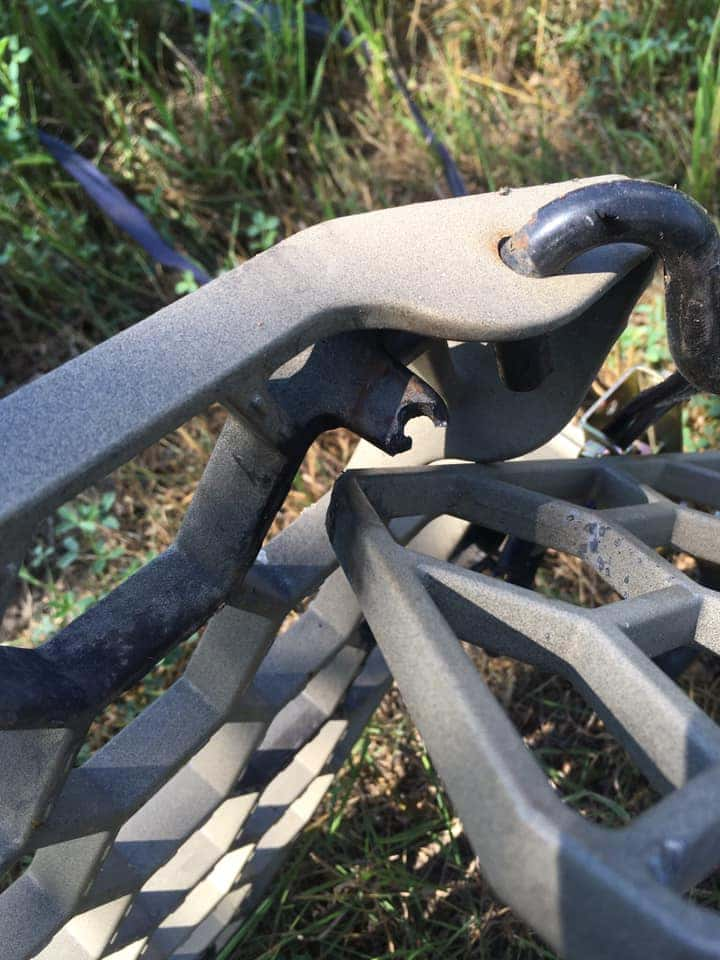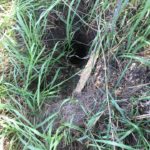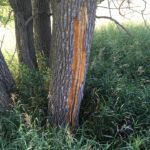
When lightning struck the author’s treestand this summer, it melted through solid metal connectors between the foot pad and seat support.
By Nick Simonson
Frayed fabric straps, bolts blown loose in the wind, tangled paracord hoist lines, even squirrel-gnawed butt seats are all common possibilities this time of year during stand inspection season.
While I’ve remedied the latter by pulling all of the removable pads in at the end of each autumn, it’s an important time of year in terms of safety and in taking stock of equipment and its condition ahead of the archery season. Up until this point in my decade-long obsession with trail cameras, tree stands and all things leading up to deer hunting, some rodent-related damage was the apex of all setbacks I had encountered in the field. That is until yesterday afternoon.
From my perch against the northernmost trunk in a cluster of boxelders on the eastern edge of a haylot hemmed into a vee by a small creek which drained into an only slightly larger river, I watched as does and fawns filtered into the open area on the far side of the field and fed each morning and evening of the early bow season last year. As the autumn wore on, bucks rabid with the rush of the rut ran pell-mell through the brush on the northeast side chasing after the same resident does.

Well over 80 yards from my stand and out of any comfortable range, I abandoned my perch and tucked myself in the brush along the bend in the field and had three close encounters with antlerless deer in the late season which convinced me that a move this summer would be in order. So, with last season’s insight in mind, I headed out to disconnect the stand from the tree after identifying a trunk which would better serve me along the high-traffic edge of the field.
Approaching the stand I noted two brown strips, the first starting at the seat of the stand and extending up into the branches of the tree, about six feet in length.
Below that, at the point where the stabilizer bar remained locked in place around the trunk by the still-attached camouflage ratchet strap, another barkless strip was evident all the way to the base of the tree. As I walked up, I began to grow concerned that a mountain lion or another critter with tree climbing ability had utilized my stand in the off season.
Gripping the ladder, I looked down to see a giant hole dug out beneath the right leg of the stand. My fears of a skunk, or badger or wolverine or something with claws and teeth and a nasty temperament caused me to take a step back as I angled my head and peered into the dugout hole. As I did, I noted a second one below the left leg of the ladder stand, and presumed whatever it was had tunneled beneath the perch, definitely compromising the integrity of the area, and further supporting my decision to move the structure.
With a shake, I took a few steps up to the point where an angle support connected the foot pad of the stand to the ladder had disconnected and I placed a bolt in the empty hole I had noted in the winter when I left it for the last time after the late-season ground hunt. Screwing the nut on the far side, I gawked at how the hole had expanded from about a quarter inch to well over a half, and the metal around it was in part singed in black and the rest had the matte green paint scraped clean off of it. Where the bolt was in place on the far side bore the same markings, charred and rusted on one side, scraped silver on the other. With each step up toward the platform, I noted the same markings at each connection point.

With the stand still stable, however, I began the process of undoing the ratchet straps which held the seat and the base in place against the tree.
As I wiggled the top strap loose, the seat came free in my hand and I tightened my grip on the base with my off hand. Surprised by the sudden pop and thinking sabotage, I caught my balance and my mental bearings and a glimpse of an area of dark, burnt metal in the portion I held.
The tops of each grommet designed to create the folding hinge of the seat were completely melted through. Black burns stained what remained of the once circular structure, now left in the shape of a charred and jagged U. It was then that the circumstantial evidence piled up and hit me…like the bolt of lightning which had obviously struck the stand sometime over the summer.
The bark had blasted off above the stand and down to the ground because the metal of the foot pad and the stability bar which carried the current was wedged deep into the tree’s surfaces by ratchet straps at those points. The bolts, with their slightest gaps and openings, and different materials, I suppose, caused flashpoints that allowed the same energy to escape, and in the process, char, burn and pop them loose. The presumed badger holes, dug some 16 feet deep into the soil, were not home to any animals, but rather were likely the terminus of the electric shock that struck the stand, and the spray of dirt propelled several feet out from each, was evidence of nature’s power.
Bewildered, I pulled the stand down. Structurally it was still solid and strong, but with slight bends, blown bolts expanded holes and the permanent damage to the seat, it would be unsafe and unusable.
Disappointing in the fact that not only it meant another trip to stink up the area with some elbow grease ahead of the season, but also because this particular telescoping model stand I had come to love for its portability and use on just about any tree, had been discontinued five years ago, and was no longer available, even in the deepest corners of the internet’s online bazaar. With it’s haul back to town, disassembly and piling into the dumpster, it signaled the end of an era, and one of the most shocking outdoor discoveries I had ever made.
